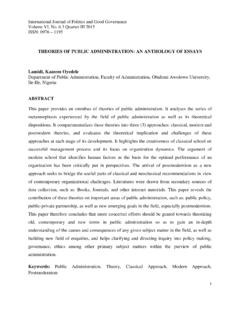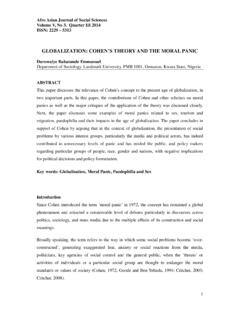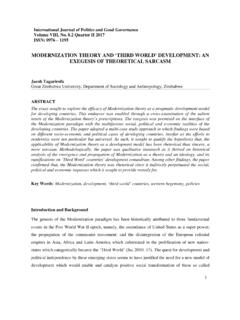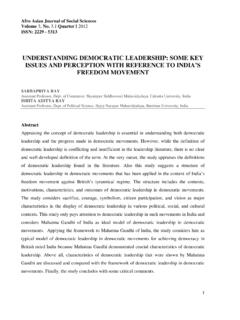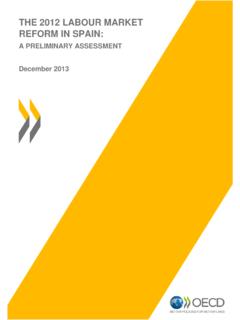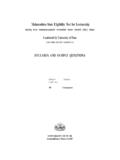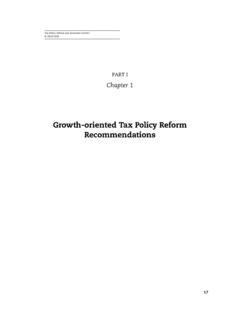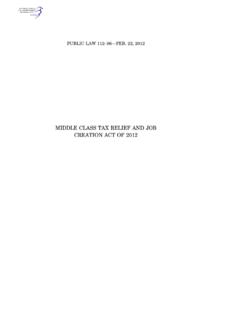Transcription of PENSIONS REFORM IN NIGERIA: A COMPARISON …
1 Afro Asian Journal of Social Sciences Volume 3, No. Quarter I 2012 ISSN: 2229 - 5313 1 PENSIONS REFORM IN nigeria : A COMPARISON BETWEEN THE OLD AND NEW SCHEME ODIA, Lecturer, Department of Accounting, University of Benin, nigeria OKOYE, A. E. Professor, Department of Accounting, University of Benin, nigeria Abstract The history of the Nigerian PENSIONS administration dates back to the pension Reforms Act of 2004 brought into limelight the new pension scheme in nigeria which is a defined contributory scheme unlike the old scheme which was largely defined benefits. Although the new scheme is being adjudged to be better than the old scheme in that it is expected to help remedy the deficiencies and inadequacies prevalent in the old scheme, it is advocated that only proper coordination, supervision and regulation of the pension industry in nigeria will make to happen.
2 Key words: pension , pension scheme, retirement benefits, pension fund administrators Introduction The issue of pension has received much attention in many countries over the past decades. In fact, in recent times, pension has increasingly attracted the attention of policy makers in many countries as a means of facilitating privately funded retirement income savings by an ageing workforce (World Bank, 1994).Many countries have opted for various forms of contributory pension scheme where employers and their employees are supposed to pay a certain percentage of the employee s monthly earnings to a retirement savings accounts from which they would be drawing their pension benefits after retirement. Besides pension funds are now among the most important institutional Afro Asian Journal of Social Sciences Volume 3, No.
3 Quarter I 2012 ISSN: 2229 - 5313 2 investment in the world capital markets (Klumpes and Mason, 2000). nigeria adopted for the contributory pension scheme following her PENSIONS REFORM in 2004. pension is the amount paid by government or company to an employee after working for some specific period of time, considered too old or ill to work or have reached the statutory age of retirement. It is monthly sum paid to a retired officer until death because the officer has worked with the organization paying the sum (Adam, 2005:468). pension is also the method whereby a person pays into pension scheme a proportion of his earnings during his working life. The contributions provide an income (or pension ) on retirement that is treated as earned income .This is taxed at the investors marginal rate of income tax.
4 On the other hand, gratuity is a lump sum of money payable to a retiring officer who has served for a minimum period of term year (now five years with effect from 1/6/92). A greater importance has been given to pension and gratuity by employers because of the belief that if employees future needs are guaranteed, their fears ameliorated and properly taken care of, they will be more motivated to contribute positively to organization s output. Similarly various governments organizations as well as labour union have emphasized the need for sound, good and workable pension scheme (Adebayo, 2006, Rabelo, 2002). The objective of this paper is to consider the pension scheme in nigeria by comparing the old scheme with the new pension scheme which came into existence through the pension Reforms Act of first part of the paper considers a brief history of the pension system in nigeria .
5 Thereafter, the problems and characteristic features associated with the old pension scheme is examined. In the next section, the pension REFORM Act of 2004 is explored in great detail by looking at some of the provisions. The last section compares the old and the new pension scheme. History of the Nigerian pension Industry One of the oldest documents to discuss social support was the Code of Hammurability by King Hammurabus of Babylon in the 18th century (Momoh and Idomeh ,2008). For instance, the code defined the rights of evildoers and orphans to the estates of their Afro Asian Journal of Social Sciences Volume 3, No. Quarter I 2012 ISSN: 2229 - 5313 3 relations. According to Bloom (2005), one of the first publicly financed social security systems was developed in the late 16th century in England from a series of legislature Acts known as poor laws.
6 Under these laws, local governments built large alms-house facilities that housed the people too old or unfit for work. Poor laws also established work houses and facilitated public housing for the employed. Moreover, these laws gave rise to the social insurance in Europe and social security in the United States (Momoh and Idomeh , 2008) The pension system was introduced into nigeria by the Colonial Administration. The first legislative document on pension in nigeria was the 1951 pension Ordinance which has retroactive effect from January 1, 1946. The Ordinance provided public servants with both pension and gratuity (Ahmed, 2006). The National Provident Fund (NPF) scheme established in 1961 was the first legislation to address pension matters of private organizations in nigeria . This was the first social protection scheme for the non-pensionable private sector employees in nigeria .
7 It was mainly a saving scheme where both employee and employer contributed the sum of N4 each on monthly basis. The scheme provided for only one-off lump sum benefit (Ahmad, 2006). The NPF was followed by Armed Forces pension Acts No 103 also of 1972 and by the pension Acts No. 102 of 1979, 18 years later .The pension Acts N 102 of 1976 which commenced on 1st April, 1974 encompassed the recommendation of Udoji Commission which included all consolidated enactments and circulars on pension as well as repealing existing 113 pension laws hitherto in force. Other pension Acts included: pension Rights of Judges Act No 5 of 1985, the Police and other Government Agencies pension Scheme enacted under pension Acts of 1987 and the Local Government pension edict which culminated in the setting of the Local Government Staff pension Board of 1987.
8 In 1993, the National Social Insurance Trust Fund (NSITF) scheme was set up by Decree No. 73 of 1993 to replace the defunct NPF scheme with effect from 1st July 1994 to cater for employees in private sector of the economy against laws of employment men in old age, invalidity or death (Balogun, 2006). In 1997, parastatals were allowed to have individual pension arrangements for their staff and appoint Boards of Trustees (BOT) to administer their pension plans as specified in the Standard Trust Deed and Rules prepared Afro Asian Journal of Social Sciences Volume 3, No. Quarter I 2012 ISSN: 2229 - 5313 4 by the Office of Head of Service of the Federation. Each BOT was free to decide on whether to mention an insured scheme or self-administered arrangement. It must be recall that the first private sector pension scheme in nigeria set up for the employees of the Nigerian Breweries was in United African Company (UAC) scheme followed in 1957.
9 The Chilean Model the wrong Imitation by nigeria Dostal and Cassey (2007) argued that the Nigerian Authority saw the Chilean reforms (Chilean model) to be emulated and copied. But she failed to learn the lessons of Chile. In fact, at the time nigeria was coping, Chile was preparing for an alternative social pension scheme. Again while the Nigerian government was beginning to give serious attention to pension REFORM (using the Chilean model) in early 2005 the Chilean model was being criticized by supporters of the scheme and the World Bank had come to conclude that the Chilean REFORM model has not delivered the benefits that it was set out for from the beginning because of the too many assumptions made. Therefore, it was advocated that to realize the claims, other reforms were also required to complement or precede pension reforms (Gill, Packard and Yermo, 2005, Holz and Hinz, 2005, World Bank 2005).
10 Similarly, the Chilean government announced wide-ranging changes to the pension provision since 2006, placing greater emphasis on solidarity and tax financing and higher controls on the operations of the individual accounts to which employees are subscribed (Gobierno de Chile, 2000). Again the World Bank has claimed that it advised against the establishment of a multi-pillar system in nigeria on the grounds that the financial sector was insufficiently developed (World Bank, 2005). Notwithstanding the reforms undertaken in nigeria was radical, involving the setting of a new basis for determining PENSIONS and the establishment of new delivery structures. Divisions of the pension Scheme pension scheme is broadly divided into the defined contribution plan and the defined benefits plan. In defined contribution plan, a contribution rate is fixed.

